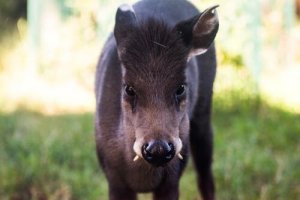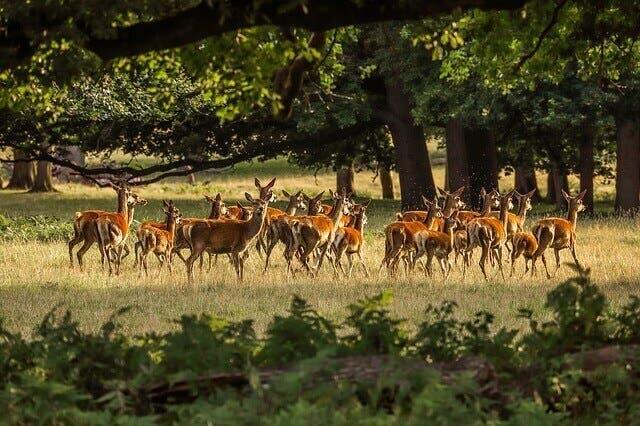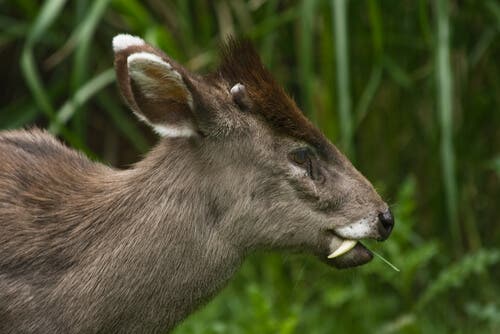Elaphodus Cephalophus: Discover the Tufted Deer


Written and verified by the biologist Ana Díaz Maqueda
The tufted deer (Elaphodus Cephalophus) is an animal that looks like it came from a medieval fantasy saga. However, this species actually exists. This small deer possesses fang-like canine teeth, which is very peculiar since, like all deer, the tufted deer is an herbivore.
Below, we’ll tell you more about this peculiar species from central Asia. You’ll discover its main characteristics and why researchers continue to study its habitat, even though they already have some information.
The tufted deer: peculiar but real
Before going over the characteristics of the tufted deer, it’s important to keep one important detail in mind.
In the past, all deer were relatively small in size and possessed both antlers and fang-like teeth. However, thanks to the pressures of evolution and natural selection, deer split into two large groups. The first group consisted of deer with antlers, which were larger. And, on the other hand, deer with fangs, which were smaller. Among this latter group, we also find muntjacs, Siberian musk deer, and water deer.

As we’ve already mentioned, the most remarkable feature of these small hoofed animals is the two fang-like canines that come out of their mouths. These teeth can be very long, sharp, and wide. However, they only appear in males of the species.
According to studies, these fangs help them fight against other males during the ritual battles that take place during courting. What’s more, on occasions, just showing their fangs can drive other males to run away.
There’s no evidence to suggest that these teeth serve any purpose when it comes to the tufted deer’s diet. In fact, their diet consists of herbaceous plants, fruits, and bamboo. Therefore, these deer are herbivorous animals.
The females among this species don’t possess fangs. Experts believe that males have them in order to fight against their competitors during courtship.
Fangs and other peculiarities
Tufted deer are small in size, between some 20 and 28 inches in height at their withers. Just the same, they’re larger than the rest of the species in their group. They’re slim and slender, with a wide variation in weight between one specimen and another. Tufted deer can weigh anywhere between 37 and 110 pounds.
Their fur is thick, consisting of short and rigid hairs that are very dark brown in the winter and somewhat lighter in the summer. On the top of their heads, they have a tuft of longer hairs, which is where they get their name. The tuft is shaped like a horseshoe and is darker than the hair on the rest of the body.

While it’s hard to tell, given their fur, male tufted deer also possess small horns on the top of their heads.
Reproduction of the Elaphodus cephalophus
Female tufted deer reach sexual maturity by the age of 9 or 10 months. At this time, females go into heat, usually around the end of autumn. Here, males begin the courtship process, which consists of sounds that are similar to barking and ritualistic battles between male specimens.
The first birth usually takes place when the deer are about a year and a half old. After a gestation of an average of 180 days, fawns are born at the end of spring or early summer. Normally, they only have one fawn, but sometimes they have two.

Other interesting facts about the tufted deer
Tufted deer tend to be solitary. However, they may move around in pairs on occasion–and not only during mating season.
At the same time, these animals have crepuscular habits. Therefore, they are much more active when there’s only a small amount of light in the sky. For example, when the sun is setting in the evening or just around dawn.
Their territories are well-defined and, therefore, they’re used to wandering the same paths. What’s more, they loiter around the same spots, leaving very clear traces. This, unfortunately, makes them easy prey to the traps that human beings set for them.
Scientists are still studying the preferred habitat of the tufted deer. Despite that, we know that these animals prefer broad-leafed rain forests. They maintain their territory near waterways and where they can find available food.
We know that this species is native to China and that, today, they inhabit the center and south of the county. However, there are also records of their existence in Burma. Just the same, experts have been unable to find any specimen living there today. This may be because they occupy a very limited, isolated region at a high elevation.
The tufted deer (Elaphodus Cephalophus) is an animal that looks like it came from a medieval fantasy saga. However, this species actually exists. This small deer possesses fang-like canine teeth, which is very peculiar since, like all deer, the tufted deer is an herbivore.
Below, we’ll tell you more about this peculiar species from central Asia. You’ll discover its main characteristics and why researchers continue to study its habitat, even though they already have some information.
The tufted deer: peculiar but real
Before going over the characteristics of the tufted deer, it’s important to keep one important detail in mind.
In the past, all deer were relatively small in size and possessed both antlers and fang-like teeth. However, thanks to the pressures of evolution and natural selection, deer split into two large groups. The first group consisted of deer with antlers, which were larger. And, on the other hand, deer with fangs, which were smaller. Among this latter group, we also find muntjacs, Siberian musk deer, and water deer.

As we’ve already mentioned, the most remarkable feature of these small hoofed animals is the two fang-like canines that come out of their mouths. These teeth can be very long, sharp, and wide. However, they only appear in males of the species.
According to studies, these fangs help them fight against other males during the ritual battles that take place during courting. What’s more, on occasions, just showing their fangs can drive other males to run away.
There’s no evidence to suggest that these teeth serve any purpose when it comes to the tufted deer’s diet. In fact, their diet consists of herbaceous plants, fruits, and bamboo. Therefore, these deer are herbivorous animals.
The females among this species don’t possess fangs. Experts believe that males have them in order to fight against their competitors during courtship.
Fangs and other peculiarities
Tufted deer are small in size, between some 20 and 28 inches in height at their withers. Just the same, they’re larger than the rest of the species in their group. They’re slim and slender, with a wide variation in weight between one specimen and another. Tufted deer can weigh anywhere between 37 and 110 pounds.
Their fur is thick, consisting of short and rigid hairs that are very dark brown in the winter and somewhat lighter in the summer. On the top of their heads, they have a tuft of longer hairs, which is where they get their name. The tuft is shaped like a horseshoe and is darker than the hair on the rest of the body.

While it’s hard to tell, given their fur, male tufted deer also possess small horns on the top of their heads.
Reproduction of the Elaphodus cephalophus
Female tufted deer reach sexual maturity by the age of 9 or 10 months. At this time, females go into heat, usually around the end of autumn. Here, males begin the courtship process, which consists of sounds that are similar to barking and ritualistic battles between male specimens.
The first birth usually takes place when the deer are about a year and a half old. After a gestation of an average of 180 days, fawns are born at the end of spring or early summer. Normally, they only have one fawn, but sometimes they have two.

Other interesting facts about the tufted deer
Tufted deer tend to be solitary. However, they may move around in pairs on occasion–and not only during mating season.
At the same time, these animals have crepuscular habits. Therefore, they are much more active when there’s only a small amount of light in the sky. For example, when the sun is setting in the evening or just around dawn.
Their territories are well-defined and, therefore, they’re used to wandering the same paths. What’s more, they loiter around the same spots, leaving very clear traces. This, unfortunately, makes them easy prey to the traps that human beings set for them.
Scientists are still studying the preferred habitat of the tufted deer. Despite that, we know that these animals prefer broad-leafed rain forests. They maintain their territory near waterways and where they can find available food.
We know that this species is native to China and that, today, they inhabit the center and south of the county. However, there are also records of their existence in Burma. Just the same, experts have been unable to find any specimen living there today. This may be because they occupy a very limited, isolated region at a high elevation.
All cited sources were thoroughly reviewed by our team to ensure their quality, reliability, currency, and validity. The bibliography of this article was considered reliable and of academic or scientific accuracy.
- Harris, R.B. & Jiang, Z. 2015. Elaphodus cephalophus. The IUCN Red List of Threatened Species 2015: e.T7112A22159620.
- Li, X., Buzzard, P., & Jiang, X. (2014). Habitat associations of four ungulates in mountain forests of southwest China, based on camera trapping and dung counts data. Population Ecology, 56(1), 251-256.
- Leslie Jr, D. M., Lee, D. N., & Dolman, R. W. (2013). Elaphodus cephalophus (Artiodactyla: Cervidae). Mammalian Species, 45(904), 80-91.
- LIU, L., & HU, J. (2008). Habitat selection by tufted deer (Elaphodus cephalophus cephalophus) in spring in Fentongzhai Nature Reserve, Sichuan Province. Sichuan Journal of Zoology, 27, 135-141.
- Redacción National Geographic. (2014). Ciervos con colmillos. National Geographic. Disponible en: https://www.nationalgeographic.es/animales/ciervos-con-colmillos
This text is provided for informational purposes only and does not replace consultation with a professional. If in doubt, consult your specialist.








